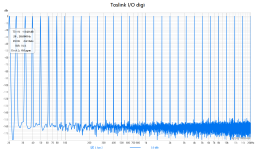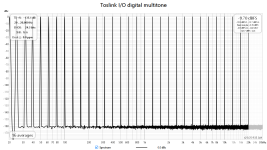IMO there must be a difference how the various SW analysis tools handle the lowest bits.


Hopefully this is insignificant for audio.
Hopefully this is insignificant for audio.
Are you using the same window function, FFT length, etc. on the two setups?IMO there must be a difference how the various SW analysis tools handle the lowest bits.
Tom
A few things occured to me that may affect the results. First the tones should not have nice math relationships. Thats kind of the point in these sequences. Phase relationship should vanish once it starts but the multitone repeating peak suggests otherwise in its file. Moving the tones to the band centers will force a math relationship since all the band centers are derived from the sample rate. I'm sure its unplesent but it would be interesting to see if the two files sound different.
Second reproducting and recording on a common clock could hide stuff (pickett fence issue). In the DA-AD test I would use unrelated clocks (44.1 play, 48 record) so nothing can hide between samples.
There was no mention of dither. Was dither on or off in the file creation? Is it even a component? But also how do the ADC's deal with the dither during capture?
How many averages are needed to know what you are seeing represents all the possibilities? Some of these tests (e.g. bit error rate) can take quite a while to get enough variations to be meaningful.
I think this is all stuff way off in the weeds but still interesting amd may yield some useful insights.
Second reproducting and recording on a common clock could hide stuff (pickett fence issue). In the DA-AD test I would use unrelated clocks (44.1 play, 48 record) so nothing can hide between samples.
There was no mention of dither. Was dither on or off in the file creation? Is it even a component? But also how do the ADC's deal with the dither during capture?
How many averages are needed to know what you are seeing represents all the possibilities? Some of these tests (e.g. bit error rate) can take quite a while to get enough variations to be meaningful.
I think this is all stuff way off in the weeds but still interesting amd may yield some useful insights.
Not necessarily. The AP 32-tone signal sounds like an out of tune pipe organ. Not exactly what I'd call melodic, but also not nails-on-chalkboard.I'm sure its unplesent but it would be interesting to see if the two files sound different.
Tom
I tried various settings and the results are basically similar with the same main difference (spuriae in REW). I also tried to add dither in REW (one may choose any bit level of dither), because the REW records may indicate to dither issue. I tried to analyze wav test signals as well.Are you using the same window function, FFT length, etc. on the two setups?
Tom
Your question points to very basic parameters which are of course taken into account. This is something hidden much deeper.
An opinion of someone who is in deep familiar and experienced with both Arta and REW might be interesting.
It seems the difference is only in the way how Arta and REW display the spectrum. I generated 32bit float 997Hz test signals in Arta and REW and they are identical. But in REW analysis RTA window they look like 24 bit undithered. However, they are both "clean" with Arta analysis window.
REW test signal

Arta test signal

As I have mentioned earlier, this is absolutely unimportant for audio, as everything discussed here recently. Just a matter of curiosity.
REW test signal
Arta test signal
As I have mentioned earlier, this is absolutely unimportant for audio, as everything discussed here recently. Just a matter of curiosity.
AFAIK REW RTA uses 32 bit floats for internal calculations. That is equivalent to 24 bit integers which would explain the higher noise floor.
That might be the reason. In REW RTA analysis, 24bit PCM, 32bit PCM and 32bit float generated test signals all look the same. But they are not and it is properly shown in both Deltawave and Arta. That might also be the reason of those multitone differences posted earlier.
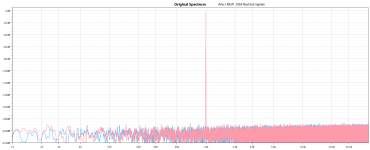
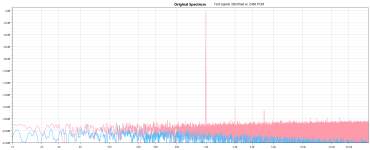
-----------
@bohrok2610 : Thanks for the hint! Mystery revealed, I need to check 64-bit checkbox in REW RTA setting and everything is as it should be.
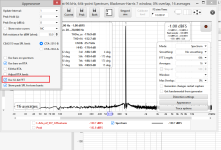

Toslink digital link is now also OK:
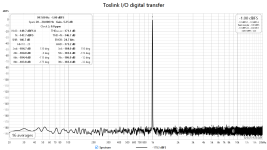


-----------
@bohrok2610 : Thanks for the hint! Mystery revealed, I need to check 64-bit checkbox in REW RTA setting and everything is as it should be.

Toslink digital link is now also OK:

Last edited:
How do you handle the fan noise from the 555? Have you felt tempted to change it to a quiet fan? (thus invalidating your warranty and giving AP a reason to give you a massive bill should it ever need a repair...). My mind boggles at the concept of having a $40K+ machine that has such a relatively high-pitched, loud fan (my various PCs - costing about 20x less - are silent). I am finding that the UPV gets 10x more use than the 555, mainly because its fan is less audibly offensive...(it's just as loud, but much lower in pitch).Not necessarily. The AP 32-tone signal sounds like an out of tune pipe organ. Not exactly what I'd call melodic, but also not nails-on-chalkboard.
Tom
The fan noise was a deal breaker for me when I looked at an APX-555. There's absolutely no excuse for a so-called SOTA audio measurement analyzer to be making so much physical noise. It rules out acoustic measurements in the immediate vicinity and overall ridiculous noise levels in an otherwise quiet environment.
I get it. Predictable thermal stability. Whatever. But seriously, twin fans, running at the same speed, resonating like mad, when car cooling designers have long used offset fan blades, different numbers of blades and variable speed fans to silence or ameliorate fan noise. It's not hard. Personally, I think Axiometrix Solutions are taking the p#ss when it comes to their customers.
They're clearly just another private-equity roll-up in 2025- not worth bothering with IMO.
And since when did DIYA start censoring words as pedestrian as ****? P#SS? Seriously? Wow...
What about P155? LOL.
I get it. Predictable thermal stability. Whatever. But seriously, twin fans, running at the same speed, resonating like mad, when car cooling designers have long used offset fan blades, different numbers of blades and variable speed fans to silence or ameliorate fan noise. It's not hard. Personally, I think Axiometrix Solutions are taking the p#ss when it comes to their customers.
They're clearly just another private-equity roll-up in 2025- not worth bothering with IMO.
And since when did DIYA start censoring words as pedestrian as ****? P#SS? Seriously? Wow...
What about P155? LOL.
Talking about really cheap, Focusrite 2i2 was also mentioned in this thread. If the requirements on lowest distortion and noise measurements are missing, 2i2 may be used for approximate measurements. There is an advantage of all-in-one, synchronized clock and balanced inputs and outputs. I strictly recommend to use this interface with balanced I/O's only. Still, there is a penalty of higher intrinsic noise of this interface. Below an example of approximate measurement. My recommendation: always think thoroughly about signal grounds and returns to get clean measurements. It is a pain to have a look at various noise floor modulations and mains spuriae in the measurements.
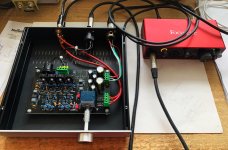
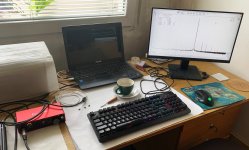
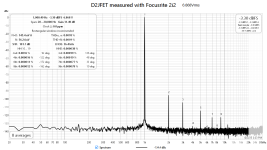



I'm finding fan noise an issue with my new Keysight meters and power supplies. Never mind an audio analyzer that costs what these do.
Running my old RF generators and spectrum analyzers is bad enough. I understand they are huge and crammed full, but the new smaller equipment is even louder many times. That and the new fans are cheap plastic things, the old ones are well made "boxer" style that last.
Running my old RF generators and spectrum analyzers is bad enough. I understand they are huge and crammed full, but the new smaller equipment is even louder many times. That and the new fans are cheap plastic things, the old ones are well made "boxer" style that last.
I choose not to be bothered by it. In general I try not to be bothered by the little things. I wanted to be able to measure ≤-140 dBc THD reliably, across many frequencies and amplitudes, and there's only one piece of equipment that can do that. So I get to deal with fan noise.How do you handle the fan noise from the 555? Have you felt tempted to change it to a quiet fan?
The AP is far lower noise than the PC I had 15-or-so years ago before I switched to Mac and discovered that computers could be silent in operation. It's also much quieter than my HP dynamic signal and network analyzers. The old HP 35xx-series is pretty loud.
Tom
Absolutely! Not everybody needs ≤-140 dBc THD measurement capability. If I designed tube amps I'd probably still be using my HP 8903A. 🙂 And if I want starting out in electronics, something like the 3rd generation Focusrite 2i2 or Solo would be high on my list of wants.Talking about really cheap, Focusrite 2i2 was also mentioned in this thread. If the requirements on lowest distortion and noise measurements are missing, 2i2 may be used for approximate measurements.
Tom
What many hi-fi designers fail to budget for is a reference quality reproduction system with electrostatic speakers in a treated room, optical phono and or top-quality tape as analog references, and the best, most true sounding dac money can buy. It costs about as much as buying a 2nd 555x (or maybe more if you have to build/remodel the room), but if you choose wisely and learn how to use it, it can help take your designs up to another level beyond what an AP analyzer can tell you. IOW, its not only about PSS HD/IMD and noise floor, and J-test jitter. One can refer to the other non-PSS problems as types of distortions or not, but they are deviations from what is on a recording.
Would you care to be more specific? Like "the other non-PSS problems as types of distortions or not, but they are deviations from what is on a recording" (examples, definitions), "many hi-fi designers fail to budget" (who and what), "it can help take your designs up to another level beyond what an AP analyzer can tell you" (like what). It is not very difficult to write down such statements as you did, but it may be more difficult to use clear language, examples and definitions to support the posted opinion.
Soundstage imaging, spectral line noise skirt sound, phase distortions at less than 1kHz or maybe 1.5kHz, what Bill Whitlock called "veiled" or "grainy" sound that you don't know you have, etc.
I don't want to embarrass anyone in this forum, but I know for a fact that an AP555x, at least as they are commonly used, isn't going to give all that information.
And I know of other people who have as many measurement instruments as anyone else here, and who truly believe in measurements, who also know what I am talking about.
I don't want to embarrass anyone in this forum, but I know for a fact that an AP555x, at least as they are commonly used, isn't going to give all that information.
And I know of other people who have as many measurement instruments as anyone else here, and who truly believe in measurements, who also know what I am talking about.
An electrostat speaker is pretty specific, and a real pain. I wouldn't, not in a million years. You are addressing a very small listening population that prefers this, a non-starter. You either design an amplifier specifically for an electrostat (I just rebuild a pair of Acoustat Servo Charge Amplifiers), or you deal with a step up transformer which bring a whole bunch of issues into the mix. I honestly don't know what anyone would be thinking if they did this without running a pair of Electrostats specific to that design of amplifier. You do know your drive level is thousands of volts - right?
A designer ought to have a good reference system, absolutely. Various speakers from reactive to benign loads. Efficient types for noise. But this is merely a sanity check.
A good audio analyzer will tell you most of what you need to know. Designers who design without such an instrument is flailing about in the dark. I have yet to hear one good component designed entirely by ear. They tend to be unreliable as well due to the underlying mindset of someone who can hear better than measured performance.
A designer ought to have a good reference system, absolutely. Various speakers from reactive to benign loads. Efficient types for noise. But this is merely a sanity check.
A good audio analyzer will tell you most of what you need to know. Designers who design without such an instrument is flailing about in the dark. I have yet to hear one good component designed entirely by ear. They tend to be unreliable as well due to the underlying mindset of someone who can hear better than measured performance.
- Home
- Design & Build
- Equipment & Tools
- Measuring Distortion on the Cheap
